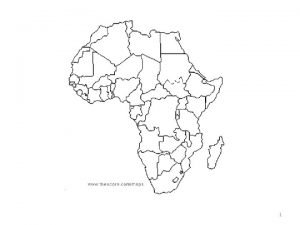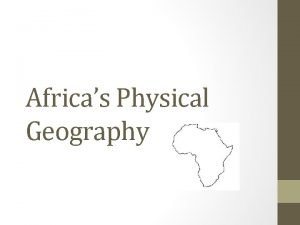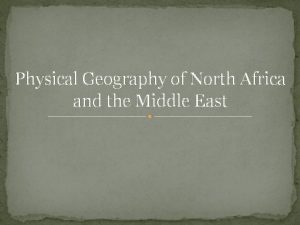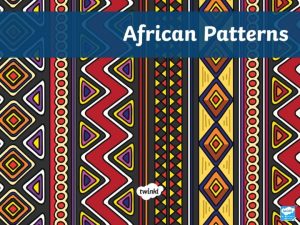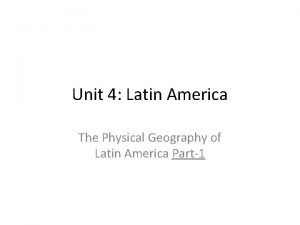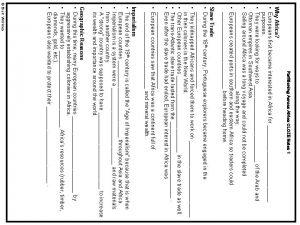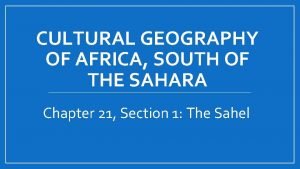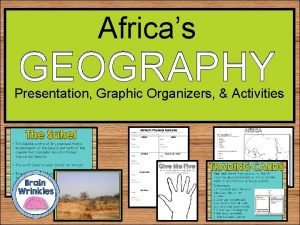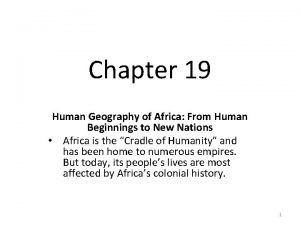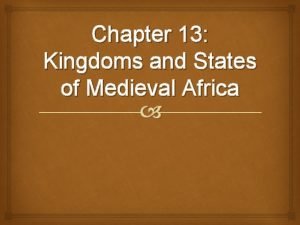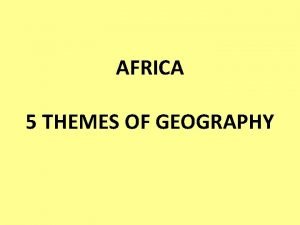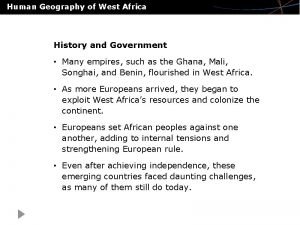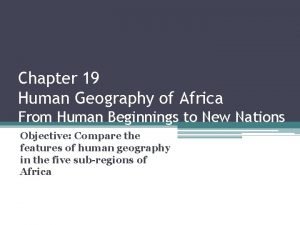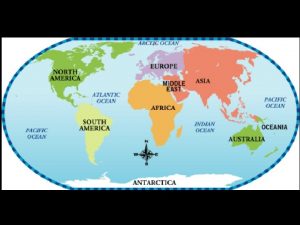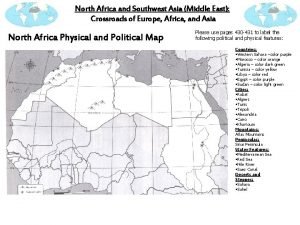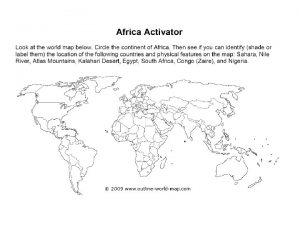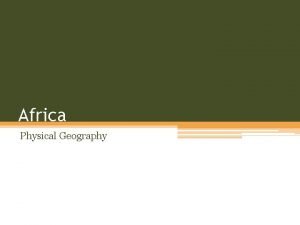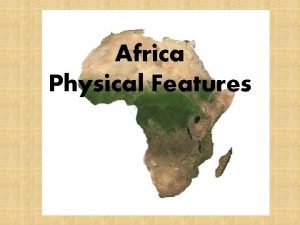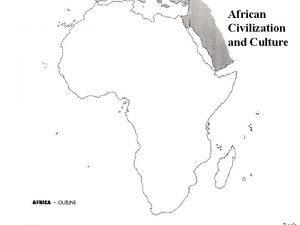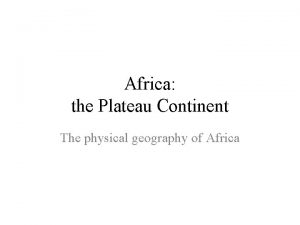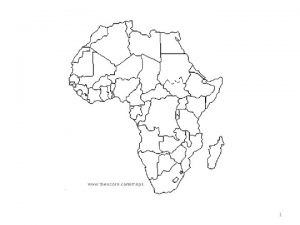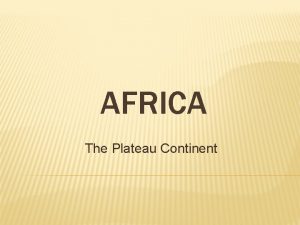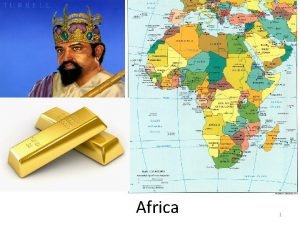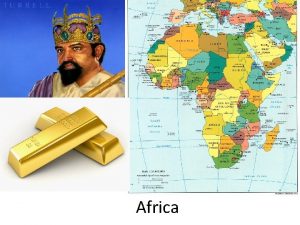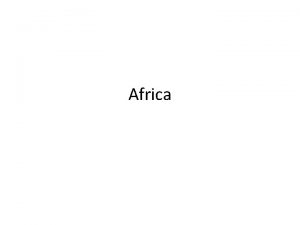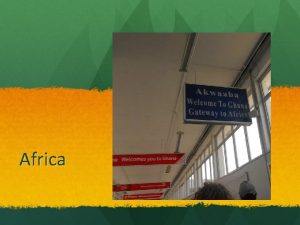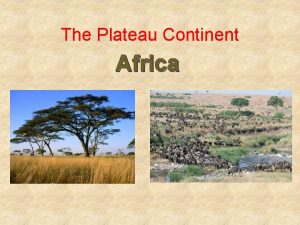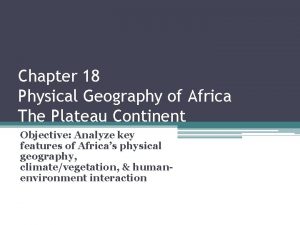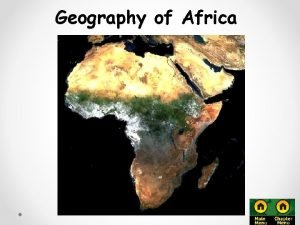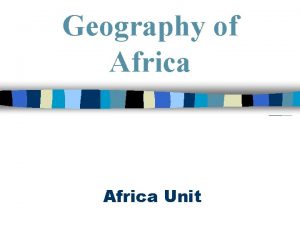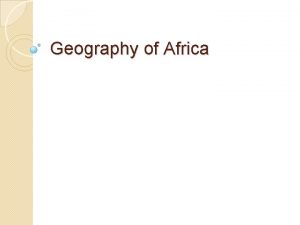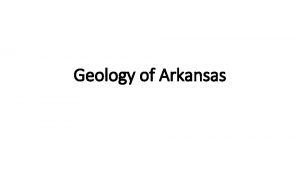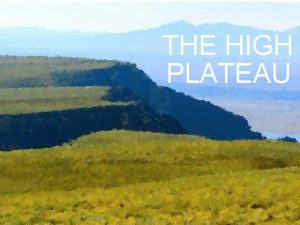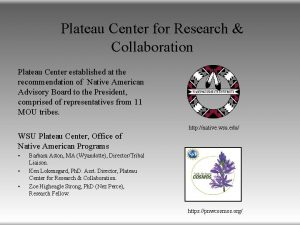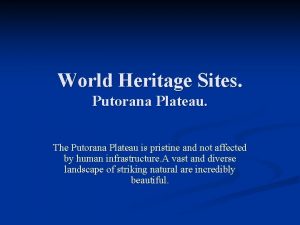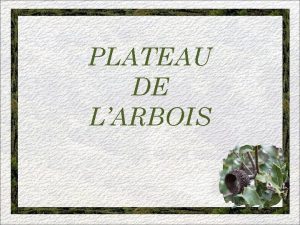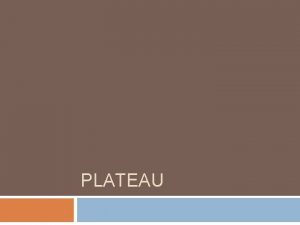1 Physical Geography of Africa The Plateau Continent

































- Slides: 33

1

Physical Geography of Africa: The Plateau Continent Africa is a continent of plateaus, basins, and rift valleys; Africa features dense rain forests, vast grasslands, and the world’s largest desert. 2

• Section 1: Landforms and Resources • Section 2: Climate and Vegetation • Section 3: Human-Environment Interaction Aswan High Dam Namib Desert 3 http: //namasteegypt. com/2010/06/24/places-to-visit-in-aswan/ Grasslands

Section 1: Landforms and Resources • A large plateau covers most of Africa. • Africa’s natural resources made it appealing to European colonizers 4 http: //www. google. com/imgres? num=10&hl=en&biw=1440&bih=760&tbm=isch&tbnid=N 1 Tvcsm 66 jb 6 q. M: &imgrefurl=http: //travelling 2009. com

A Vast Plateau http: //geology. com/pangea. htm After Pangaea • Pangaea supercontinent broke up 200 million years ago – Africa moved very little, unlike Americas, Antarctica, Australia, and India. – Africa is second largest continent. 5

http: //goafrica. about. com/od/africatraveltips/ig/Maps-of-Africa/Topographical-Map-of-Africa. htm Africa’s Plateau • Huge plateau covers most of Africa, rising inland from coasts – Most of Africa is at least 1, 000 feet above sea level – known as the “plateau continent” 6

http: //www. mitchellteachers. org/World. History/Ancient. Egypt. Near. East. Unit/Blanchette. Nile. Project/Nile. River. Project. Main. htm Basins and Rivers • Basins—huge depressions on plateau – Each is more than 625 miles across, up to 5, 000 feet deep. • Nile River —world’s longest: 4, 000 miles through Uganda, Sudan, South Sudan, and Egypt. – Waters are used for irrigation; 95% of Egyptians get water from the Nile. • Egypt’s population density near the Nile is 3, 320 people per square mile – Only 177 per square mile overall. 7

Distinctive African Landforms Basins and Rivers • Waterfalls, rapids, and gorges make rivers less useful for transportation. – 2, 900 -mile Congo is largest river network. – 32 cataracts (waterfalls) make much of Congo impassable. • Rivers’ meandering courses also make them less useful http: //apsolutionsltd. co. uk/ka-congo-river-on-map/index. htm 8

Rift Valleys and Lakes • East Africa: continental shift created huge cracks in East Africa. – Land sank, formed long, thin rift valleys. – stretch 4, 000 miles from Jordan to Mozambique – Eastern part is still slowly pulling away from Africa. • Long, deep lakes form at bottoms of rift valleys – Lake Tanganyika is the longest freshwater lake in world. – Lake Victoria is Africa’s largest lake; it sits in a basin between rift valleys. Lake Victoria 9 http: //www. escapetoafrica. net/parks/Lake-Victoria. aspx

http: //inouganda. com/mt-kilimanjaro/ Mountains • Africa mainly has volcanic mountains: Mount Kenya, Mount Kilimanjaro. – Mount Kilimanjaro is Africa’s highest mountain – Volcanoes created Ethiopian Highlands – Also Tibesti Mountains (Sahara), Mount Cameroon (West Africa) • Volcanic rock covers Great Escarpment in Southern Africa – Escarpment—steep slope with flat plateau on top 10

Africa’s Wealth of Resources A Wealth of Minerals • Africa’s minerals make it one of world’s richest continents – Copper, phosphates, diamonds; 42% of world’s cobalt. • South Africa is largest producer of chromium, for stainless steel – produces 80% of world’s platinum, 30% of gold. • Mineral wealth has not created general African prosperity – Colonial rulers sent natural resources to Europe. – Nations are slow to develop infrastructure, industries. 11

Oil Resources • Libya, Nigeria, Algeria among world’s leading petroleum producers – Angola, Gabon have untapped oil reserves http: //marketjigsawpuzzle. blogspot. com/2011/02/libya-corporate-threat-assessment. html • Angola is example of resources not benefiting Africans – Oil deposits will make it Africa’s most oil-rich country – American companies will pay Angola to drill oil – Money will be spent on ongoing ethnic civil war – Little will be invested in schools, hospitals, and other infrastructure 12

Diversity of Resources Major Commodities • Coffee is Africa’s second most profitable commodity – Few Africans drink coffee, but 20% of world’s supply is grown there. • Nigeria leads in lumber exports, but logging is depleting forests. – Each year an area twice the size of New Jersey is cleared. • Other commodities include sugar, palm oil, and cocoa. • Agriculture is Africa’s single most important economic activity – 66% of Africans earn a living farming; this accounts for 1/3 of their exports. 13

Section 2: Climate and Vegetation • Africa contains dry and hot deserts, warm tropics, and permanently snowcapped mountains. • Africa’s vegetation includes thick rain forests, tall grasslands, and desert areas. 14

A Warm Continent The Deserts http: //www. wonderfulinfo. com/winfo/naturalwonders/ • Sahara is largest desert in world; name means “desert” in Arabic. – 3, 000 miles from Atlantic to Red Sea; 1, 200 miles north to south. – Temperatures as high as 136 degrees in summer, and freezing at night. – Fewer than 2 million of Africa’s 800 million people live in the Sahara. • Only 20% is sand; rest is mountains, rocks, or gravelly plains. – Tibesti Mountains in northwestern Chad rise 11, 000 feet 15

http: //www. worldofstock. com/stock-photos/mandara-oasis-libya-north-africa/TAF 2481 The Deserts • Saharan travelers rely on camels that can go 17 days without water. • 6, 000 feet under Sahara are aquifers—stores of underground water. – When this water comes to the surface it creates an oasis. • Other African deserts include Kalahari, and the Namib. 16

The Tropics • Africa has the largest tropical area of any continent. 17 http: //www. wildlifeden. com/projects/tropic-of-capricorn/ – 90% of Africa lies between tropics of Cancer, and Capricorn. – High temperatures year around; especially in Somalian Sahara. – Africans say nighttime is the “winter” of the tropics.

Sunshine and Rainfall Patterns • Rains all year in rain forests; most of Africa has rainy seasons. • Tropical savanna covers half of Africa; six-month rainy season. • Longer rainy seasons near equator; longer dry seasons near desert. • West coast gets heavy rain; Monrovia, Liberia, has 120 inches yearly. • Sahara, other deserts may go years without rain. 18

Africa’s Moderate Areas • Mediterranean climate on northern, southern tips of Africa – clear blue skies, moderate summers, rain in winter 19 http: //www. naturalhistoryonthenet. com/Continents/africa. htm

A Grassy Continent Tropical Grassland • Tropical grassland covers most of Africa • Serengeti Plain —northern Tanzania grassland – dry climate, hard soil prevent growth of trees, crops • Serengeti National Park has best grasslands in the world – some grasses grow taller than a person – ideal for grazing animals like wildebeests, gazelles, zebras – site of largest numbers of migrating land mammals 20 http: //www. ganeandmarshall. com/destination/Tanzania/Serengeti-National-Park. html

Africa’s Extremes Rain Forest • Major tropical rain forests are on equator in the Congo Basin. • A square acre can have hundreds of different types of trees, and birds. – Plants, trees, leaves block out most sunlight; air is hot, moist. – Plants, vegetation decay 8 times faster than in Europe • Most animals live in canopy— uppermost branches, 150 feet off ground. – Birds, monkeys, flying foxes, and snakes can live in the canopy. 21 http: //mrsgebauer. com/rainforestweb/Web. Quest. htm

Rain Forest • Farmers’ slash-andburn methods endanger rain forest. – Madagascar’s rain forest is almost completely gone. – Some estimate over half of Africa’s original rain forests are gone. http: //www. wildmadagascar. org/overview/ecosystems. html 22

Varieties of Plant Life • Oak, and pine forests are in the Atlas Mountains of North Africa. • Mangrove trees grow along the West African river banks. – Roots are breeding grounds for fish. – Roots help build dry land by holding silt. Mangrove Tree 23 http: //forums. wesnoth. org/viewtopic. php? f=19&t=30104&start=165

Section 3: Human-Environment Interaction • The Sahara’s expansion is causing problems for Africa’s farmers. • The Nigerian oil industry has caused serious environmental damage in the Niger delta. 24

Desertification of the Sahel The Spreading Sahara • Sahel means “shore of the desert” – Narrow band of grassland runs east-west along southern Sahara edge – used for farming, and herding. • Since 1960 s, desert has spread into the Sahel. – Desertification—expansion of dry conditions into nearby moist areas – Both natural and long-term desertification cycles have been sped up by human activity. 25

Human Causes of Desertification • Livestock- overgrazing exposes and tramples soil, increases erosion. • Clearing land for farming increases erosion. • Water drilling, and irrigation increase soil’s salt levels. – Vegetation growth is stunted. • Population levels require more crop land, more fuel (wood) to burn. 26

Results of Desertification • Forests around Khartoum (Sudan), and Lake Chad are vanishing. – Some countries are planting trees to slow desertification. Desertification is threatening the ecosystems of the Sahel! 27 http: //oceanworld. tamu. edu/resources/oceanography-book/desertificationinsahel. html

Harming the Environment in Nigeria A Major Oil Producer • Oil was discovered in Nigeria in 1956 in the Niger delta. • Nigeria is world’s 6 th leading oil exporter. – There are 2 million barrels of oil extracted each day; most shipped to U. S. – Oil provides up to 90% of national income. • In 1970 s, high oil prices made Nigeria one of Africa’s richest nations. – When prices fell, Nigeria owed millions to other nations, U. S. – Poor planning, and corruption helped leave Nigeria poorer than ever before. 28

Destroying the Land People – Acid rain and soot from oil fires lead to respiratory diseases. • Pipeline explosions kill 2, 000 between 1998 and 2000 – Bandits work with corrupt officials; drain pipeline fuel, and sell it. A ruptured pipeline in Nigeria 29 http: //www. france 24. com/en/20080515 -pipeline-explosion-kills-100 -nigeria-nigeria • There have been over 4, 000 oil spills in four decades with slow or no cleanup.

– fires corrupt officials, and begins economic reform. 30 http: //bebeakinboade. blogspot. com/2012/04/former-president-olusegun-obasanjo. html A New Start • Olusegun Obasanjo became the new Nigerian president in 1999.

Controlling the Nile The Aswan High Dam • Egyptians have always tried to control the Nile’s flood, and droughts. http: //tourism-egyptnow. blogspot. com/2011/05/aswan-high-dam. html – built first Aswan Dam in 1902; quickly obsolete. • Aswan High Dam completed in 1970, creates 300 -mile Lake Nasser. • Dam provides regular supply of water for farmers – holds back Nile floodwaters for irrigation – Farmers now have two, or three harvests a year – Egypt’s farmable land increased by 50%. 31

Problems with the Dam • Construction meant relocating people, changing Nubian’s way of life. • Abu Simbel temples moved, but other treasures were lost at bottom of the lake. • River no longer deposits rich silt—sediment—on farmland • Irrigation raises water table. – River doesn’t flush out salts that decrease soil fertility. • Mosquitoes thrive in Lake Nasser and spread malaria, and other diseases. • Millions of gallons of fresh water lost yearly due to lake evaporation. 32

Bibliography • Mcdougal Littell, World Geography. Houghton Mifflin Company. 2012 33
 Continental plateau
Continental plateau Chapter 18 the plateau continent
Chapter 18 the plateau continent The plateau continent
The plateau continent Plate boundary
Plate boundary Divergent convergent transform
Divergent convergent transform Physical features of the middle east map
Physical features of the middle east map Lesson 1 physical geography of southeast asia
Lesson 1 physical geography of southeast asia North africa and southwest asia physical geography
North africa and southwest asia physical geography The geography of west africa
The geography of west africa Second largest continent
Second largest continent Escarpment definition geography
Escarpment definition geography Georgia's physical features
Georgia's physical features Africa geography cloze notes 1
Africa geography cloze notes 1 Temperate zone
Temperate zone Africa south of the sahara map
Africa south of the sahara map Brain wrinkles africa
Brain wrinkles africa Africa geography webquest
Africa geography webquest Africa geography unit test study guide
Africa geography unit test study guide Poverty during apartheid
Poverty during apartheid 13 kingdoms
13 kingdoms 5 themes of geography africa
5 themes of geography africa Medieval africa geography
Medieval africa geography Human geography of west africa
Human geography of west africa Chapter 19 human geography of africa
Chapter 19 human geography of africa Sub saharan africa physical features
Sub saharan africa physical features Southwest asia/north africa (swana) political map
Southwest asia/north africa (swana) political map Major physical features of africa
Major physical features of africa The ethiopian highlands
The ethiopian highlands Physical features of africa
Physical features of africa 2020 revised curriculum and assessment plans
2020 revised curriculum and assessment plans Outline physical map of africa
Outline physical map of africa Africa landforms
Africa landforms Southwest asia and north africa physical map
Southwest asia and north africa physical map Frq ap human geography format
Frq ap human geography format
